Min Xian
Predictive Modeling and Uncertainty Quantification of Fatigue Life in Metal Alloys using Machine Learning
Jan 25, 2025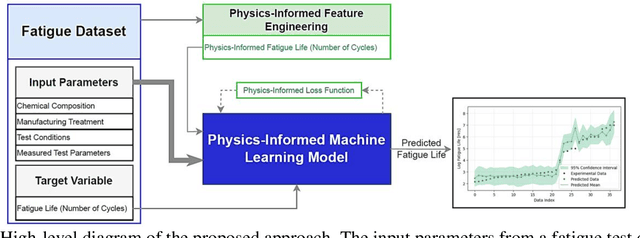
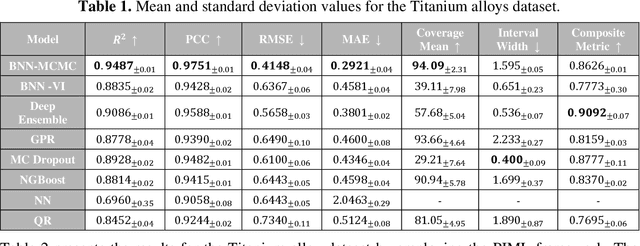
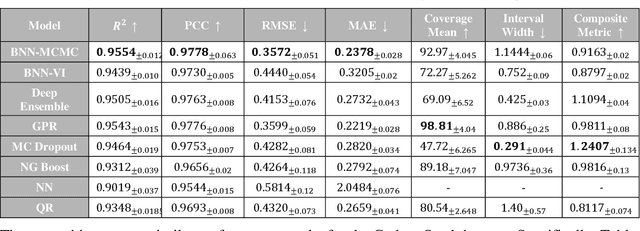
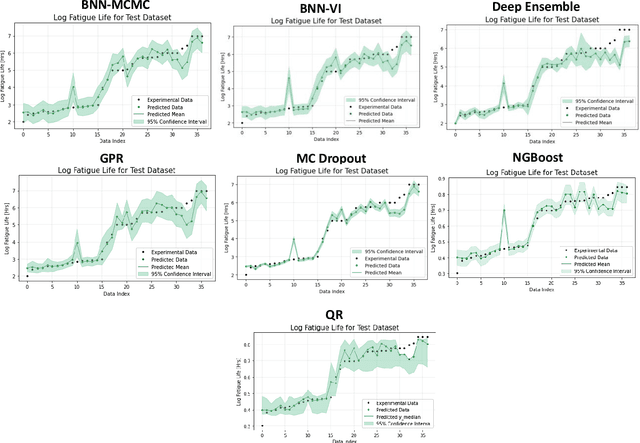
Abstract:Recent advancements in machine learning-based methods have demonstrated great potential for improved property prediction in material science. However, reliable estimation of the confidence intervals for the predicted values remains a challenge, due to the inherent complexities in material modeling. This study introduces a novel approach for uncertainty quantification in fatigue life prediction of metal materials based on integrating knowledge from physics-based fatigue life models and machine learning models. The proposed approach employs physics-based input features estimated using the Basquin fatigue model to augment the experimentally collected data of fatigue life. Furthermore, a physics-informed loss function that enforces boundary constraints for the estimated fatigue life of considered materials is introduced for the neural network models. Experimental validation on datasets comprising collected data from fatigue life tests for Titanium alloys and Carbon steel alloys demonstrates the effectiveness of the proposed approach. The synergy between physics-based models and data-driven models enhances the consistency in predicted values and improves uncertainty interval estimates.
GCSAM: Gradient Centralized Sharpness Aware Minimization
Jan 20, 2025Abstract:The generalization performance of deep neural networks (DNNs) is a critical factor in achieving robust model behavior on unseen data. Recent studies have highlighted the importance of sharpness-based measures in promoting generalization by encouraging convergence to flatter minima. Among these approaches, Sharpness-Aware Minimization (SAM) has emerged as an effective optimization technique for reducing the sharpness of the loss landscape, thereby improving generalization. However, SAM's computational overhead and sensitivity to noisy gradients limit its scalability and efficiency. To address these challenges, we propose Gradient-Centralized Sharpness-Aware Minimization (GCSAM), which incorporates Gradient Centralization (GC) to stabilize gradients and accelerate convergence. GCSAM normalizes gradients before the ascent step, reducing noise and variance, and improving stability during training. Our evaluations indicate that GCSAM consistently outperforms SAM and the Adam optimizer in terms of generalization and computational efficiency. These findings demonstrate GCSAM's effectiveness across diverse domains, including general and medical imaging tasks.
Guided and Variance-Corrected Fusion with One-shot Style Alignment for Large-Content Image Generation
Dec 17, 2024



Abstract:Producing large images using small diffusion models is gaining increasing popularity, as the cost of training large models could be prohibitive. A common approach involves jointly generating a series of overlapped image patches and obtaining large images by merging adjacent patches. However, results from existing methods often exhibit obvious artifacts, e.g., seams and inconsistent objects and styles. To address the issues, we proposed Guided Fusion (GF), which mitigates the negative impact from distant image regions by applying a weighted average to the overlapping regions. Moreover, we proposed Variance-Corrected Fusion (VCF), which corrects data variance at post-averaging, generating more accurate fusion for the Denoising Diffusion Probabilistic Model. Furthermore, we proposed a one-shot Style Alignment (SA), which generates a coherent style for large images by adjusting the initial input noise without adding extra computational burden. Extensive experiments demonstrated that the proposed fusion methods improved the quality of the generated image significantly. As a plug-and-play module, the proposed method can be widely applied to enhance other fusion-based methods for large image generation.
Do Sharpness-based Optimizers Improve Generalization in Medical Image Analysis?
Aug 07, 2024Abstract:Effective clinical deployment of deep learning models in healthcare demands high generalization performance to ensure accurate diagnosis and treatment planning. In recent years, significant research has focused on improving the generalization of deep learning models by regularizing the sharpness of the loss landscape. Among the optimization approaches that explicitly minimize sharpness, Sharpness-Aware Minimization (SAM) has shown potential in enhancing generalization performance on general domain image datasets. This success has led to the development of several advanced sharpness-based algorithms aimed at addressing the limitations of SAM, such as Adaptive SAM, surrogate-Gap SAM, Weighted SAM, and Curvature Regularized SAM. These sharpness-based optimizers have shown improvements in model generalization compared to conventional stochastic gradient descent optimizers and their variants on general domain image datasets, but they have not been thoroughly evaluated on medical images. This work provides a review of recent sharpness-based methods for improving the generalization of deep learning networks and evaluates the methods performance on medical breast ultrasound images. Our findings indicate that the initial SAM method successfully enhances the generalization of various deep learning models. While Adaptive SAM improves generalization of convolutional neural networks, it fails to do so for vision transformers. Other sharpness-based optimizers, however, do not demonstrate consistent results. The results reveal that, contrary to findings in the non-medical domain, SAM is the only recommended sharpness-based optimizer that consistently improves generalization in medical image analysis, and further research is necessary to refine the variants of SAM to enhance generalization performance in this field
Causality Extraction from Nuclear Licensee Event Reports Using a Hybrid Framework
Apr 08, 2024Abstract:Industry-wide nuclear power plant operating experience is a critical source of raw data for performing parameter estimations in reliability and risk models. Much operating experience information pertains to failure events and is stored as reports containing unstructured data, such as narratives. Event reports are essential for understanding how failures are initiated and propagated, including the numerous causal relations involved. Causal relation extraction using deep learning represents a significant frontier in the field of natural language processing (NLP), and is crucial since it enables the interpretation of intricate narratives and connections contained within vast amounts of written information. This paper proposed a hybrid framework for causality detection and extraction from nuclear licensee event reports. The main contributions include: (1) we compiled an LER corpus with 20,129 text samples for causality analysis, (2) developed an interactive tool for labeling cause effect pairs, (3) built a deep-learning-based approach for causal relation detection, and (4) developed a knowledge based cause-effect extraction approach.
A2DMN: Anatomy-Aware Dilated Multiscale Network for Breast Ultrasound Semantic Segmentation
Mar 22, 2024Abstract:In recent years, convolutional neural networks for semantic segmentation of breast ultrasound (BUS) images have shown great success; however, two major challenges still exist. 1) Most current approaches inherently lack the ability to utilize tissue anatomy, resulting in misclassified image regions. 2) They struggle to produce accurate boundaries due to the repeated down-sampling operations. To address these issues, we propose a novel breast anatomy-aware network for capturing fine image details and a new smoothness term that encodes breast anatomy. It incorporates context information across multiple spatial scales to generate more accurate semantic boundaries. Extensive experiments are conducted to compare the proposed method and eight state-of-the-art approaches using a BUS dataset with 325 images. The results demonstrate the proposed method significantly improves the segmentation of the muscle, mammary, and tumor classes and produces more accurate fine details of tissue boundaries.
Uncertainty Quantification in Multivariable Regression for Material Property Prediction with Bayesian Neural Networks
Nov 04, 2023Abstract:With the increased use of data-driven approaches and machine learning-based methods in material science, the importance of reliable uncertainty quantification (UQ) of the predicted variables for informed decision-making cannot be overstated. UQ in material property prediction poses unique challenges, including the multi-scale and multi-physics nature of advanced materials, intricate interactions between numerous factors, limited availability of large curated datasets for model training, etc. Recently, Bayesian Neural Networks (BNNs) have emerged as a promising approach for UQ, offering a probabilistic framework for capturing uncertainties within neural networks. In this work, we introduce an approach for UQ within physics-informed BNNs, which integrates knowledge from governing laws in material modeling to guide the models toward physically consistent predictions. To evaluate the effectiveness of this approach, we present case studies for predicting the creep rupture life of steel alloys. Experimental validation with three datasets of collected measurements from creep tests demonstrates the ability of BNNs to produce accurate point and uncertainty estimates that are competitive or exceed the performance of the conventional method of Gaussian Process Regression. Similarly, we evaluated the suitability of BNNs for UQ in an active learning application and reported competitive performance. The most promising framework for creep life prediction is BNNs based on Markov Chain Monte Carlo approximation of the posterior distribution of network parameters, as it provided more reliable results in comparison to BNNs based on variational inference approximation or related NNs with probabilistic outputs. The codes are available at: https://github.com/avakanski/Creep-uncertainty-quantification.
Post-Hoc Explainability of BI-RADS Descriptors in a Multi-task Framework for Breast Cancer Detection and Segmentation
Aug 27, 2023



Abstract:Despite recent medical advancements, breast cancer remains one of the most prevalent and deadly diseases among women. Although machine learning-based Computer-Aided Diagnosis (CAD) systems have shown potential to assist radiologists in analyzing medical images, the opaque nature of the best-performing CAD systems has raised concerns about their trustworthiness and interpretability. This paper proposes MT-BI-RADS, a novel explainable deep learning approach for tumor detection in Breast Ultrasound (BUS) images. The approach offers three levels of explanations to enable radiologists to comprehend the decision-making process in predicting tumor malignancy. Firstly, the proposed model outputs the BI-RADS categories used for BUS image analysis by radiologists. Secondly, the model employs multi-task learning to concurrently segment regions in images that correspond to tumors. Thirdly, the proposed approach outputs quantified contributions of each BI-RADS descriptor toward predicting the benign or malignant class using post-hoc explanations with Shapley Values.
Breast Ultrasound Tumor Classification Using a Hybrid Multitask CNN-Transformer Network
Aug 04, 2023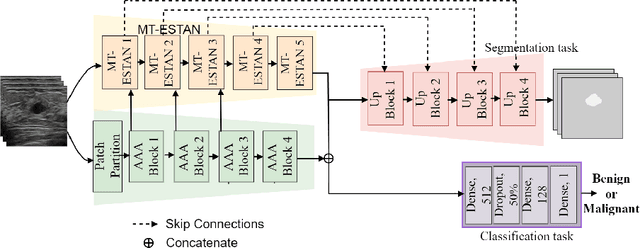

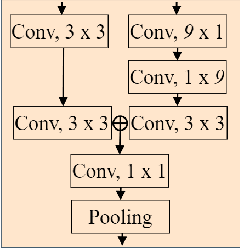
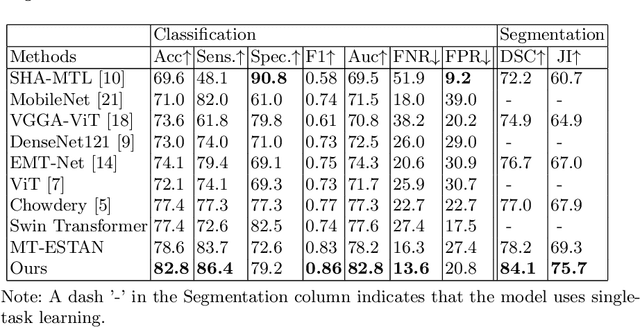
Abstract:Capturing global contextual information plays a critical role in breast ultrasound (BUS) image classification. Although convolutional neural networks (CNNs) have demonstrated reliable performance in tumor classification, they have inherent limitations for modeling global and long-range dependencies due to the localized nature of convolution operations. Vision Transformers have an improved capability of capturing global contextual information but may distort the local image patterns due to the tokenization operations. In this study, we proposed a hybrid multitask deep neural network called Hybrid-MT-ESTAN, designed to perform BUS tumor classification and segmentation using a hybrid architecture composed of CNNs and Swin Transformer components. The proposed approach was compared to nine BUS classification methods and evaluated using seven quantitative metrics on a dataset of 3,320 BUS images. The results indicate that Hybrid-MT-ESTAN achieved the highest accuracy, sensitivity, and F1 score of 82.7%, 86.4%, and 86.0%, respectively.
Multi-Level Global Context Cross Consistency Model for Semi-Supervised Ultrasound Image Segmentation with Diffusion Model
May 17, 2023Abstract:Medical image segmentation is a critical step in computer-aided diagnosis, and convolutional neural networks are popular segmentation networks nowadays. However, the inherent local operation characteristics make it difficult to focus on the global contextual information of lesions with different positions, shapes, and sizes. Semi-supervised learning can be used to learn from both labeled and unlabeled samples, alleviating the burden of manual labeling. However, obtaining a large number of unlabeled images in medical scenarios remains challenging. To address these issues, we propose a Multi-level Global Context Cross-consistency (MGCC) framework that uses images generated by a Latent Diffusion Model (LDM) as unlabeled images for semi-supervised learning. The framework involves of two stages. In the first stage, a LDM is used to generate synthetic medical images, which reduces the workload of data annotation and addresses privacy concerns associated with collecting medical data. In the second stage, varying levels of global context noise perturbation are added to the input of the auxiliary decoder, and output consistency is maintained between decoders to improve the representation ability. Experiments conducted on open-source breast ultrasound and private thyroid ultrasound datasets demonstrate the effectiveness of our framework in bridging the probability distribution and the semantic representation of the medical image. Our approach enables the effective transfer of probability distribution knowledge to the segmentation network, resulting in improved segmentation accuracy. The code is available at https://github.com/FengheTan9/Multi-Level-Global-Context-Cross-Consistency.
 Add to Chrome
Add to Chrome Add to Firefox
Add to Firefox Add to Edge
Add to Edge